Linda Linda Linda
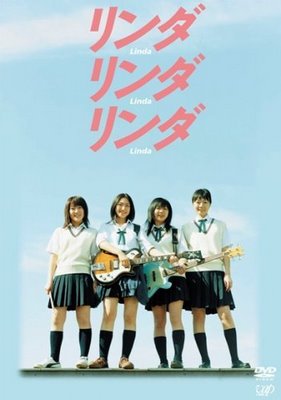
Linda Linda Linda is a film about four girls who put together a band to perform at their yearly high school festival. They get together, they practice (a lot), and they play. And that's the film, pretty much. No big surprises. No huge drama. No "bad guys" to overcome. And you know what? It's awesome. The film is slice-of-life in its purest form, showing how magical life can be if you just put your all into living it. More specifically, it's about how special an experience high school is and why young people should make a point of enjoying it.
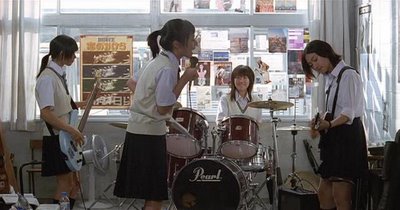
There are two scenes right near the beginning of this film that display exactly what makes it so great. The first is a steady, extended tracking shot of character Kyoko (played by Aki Maeda of Battle Royale fame) walking down the hallway of her high school and passing by several rooms full of students busily preparing for the festival. The shot stands out for several reasons: one, it's obviously a well planned scene, with events (from instances of dialogue to little things like the popping of balloons in the background) happening in a carefully timed sequence. Two, it features no special effects, no excess of style, and no attempts by the filmmakers to insert themselves into the scene by adding anything that doesn't make things seem more realistic. But what's most important about this scene is how natural it feels. The scene isn't designed to make viewers say, "Hey, that's a neat tracking shot." Instead, it's designed to immerse them in the world of the film, giving them the idea that they are observers of real events happening in real life. We are not watching an actress make her way through a building cluttered with extras and delivering lines at proscribed moments. We are watching a high school student moving through a mass of her peers who are all busy putting together one of the most important events of their school lives.
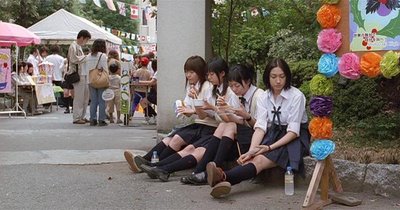
That basically defines the design philosophy behind this film. The only "style" present is that of realism. The festival serves as an excellent backdrop to the story, as the persistent flow of chaotic energy and life at the school really drives home the sense of authenticity that the film strives to achieve.
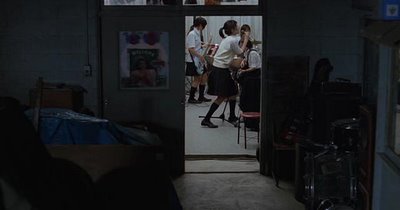
Amidst all this, the camera is but a passive observer, serving only as a window on the events taking place. Director Nobuhiro Yamashita doesn't feel the need to attempt all sorts of wacky camera angles or CGI effects, instead opting to sit back and let things happen the way they would in real life. However, that doesn't mean he didn't put an enormous amount of thought into every shot. The camera always seems to be in just the right place to give each scene the maximum effect and clarity. It's a simple but honest approach that I really appreciate. And that's exactly what the film is: simple and honest.
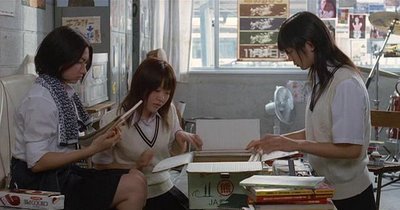
The other defining scene that occurs early in the film is one in which the girls in the band are trying to decide what songs they're going to play at their performance. Their band lineup has recently had a major shakeup, and the remaining members don't have time to write original songs before the show, so they're sifting through the music club's media collection to find a band or artist whose songs they'd like to cover. The first suggestion? Ringo Shiina. The response? "Too hard." Next up is Puffy. "Are you serious?" says guitarist Kei (Yu Kashii) to Kyoko (who is the band's drummer), "Are you going to sing?"
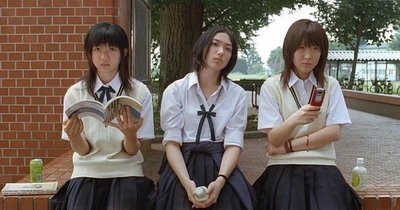
Then bass player Nozomi (played by Base Ball Bear bassist Shiori Sekine) comes over and plops a box full of old cassette tapes on the table in front of the girls. They sift through and read the names on the cases: "Princess Princess." "The Boom." "Boowy." "Jun Sky Walkers." "Unicorn (which the girls refer to as "Tamio's band")." "Jittering Jin."
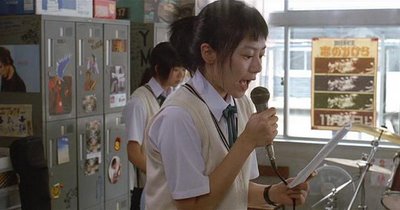
Eventually the girls settle, somewhat by accident, on The Blue Hearts; a punk band from the late 80's/early 90's that had several successful singles, chief among them the song "Linda, Linda," which - as you can guess based on the title of the film - becomes the primary song that the girls are going to cover at their performance.
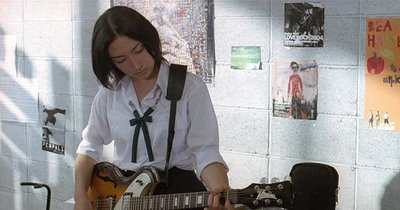
All this should make Japanese music lovers/historians such as myself giddy with the ecstasy of recognition, and it is the perfect introduction to the other major aspect of this film: the music. It's obvious that there is a deep love of music (specifically Japanese music) behind this film, as every moment is pervaded with it. There are little treats strewn throughout that will give enthusiasts much to smile about. The film is littered with great tunes, many of which should be recognizable to people who keep an eye (or ear) on the Japanese music scene. Despite the film's little poke at Puffy in that early scene, an excellent cover of one of their older tunes shows up later on. Other familiar songs pop up in the film as well, though not in the form you might expect. Even the incidental soundtrack is great, full of sparse but beautiful guitar work done by one mister James Iha (and come on, even you folks who don't know anything about Japanese music should know who he is).
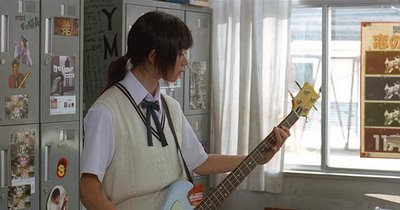
There are many other little details in the film that should please Japanese music lovers too. Just look at the posters in the club room (yeah, Led Zeppelin and Bob Dylan posters are expected, but Penpals? That's an unusual nod.). The appearance of Shione Yukawa in a secondary role is also a delight, especially because we get to hear her beautiful singing voice. And one of the best gifts that the film gives to the musically minded is the fact that when the girls play their instruments, they actually play their instruments. There's no faking here: just look at Aki Maeda banging away at those drums. That kind of musical authenticity is generally sorely lacking in films, and it's nice to see it here.
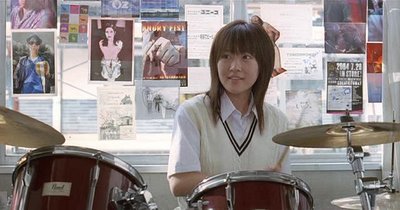
Now, just because music is so important to this film, that doesn't mean it will be inscrutable to people who have no interest in the Japanese music scene. If anything, it's possible that the film's love of music might spark some curiosity in viewers that could lead them to discovering something they really like that they'd never heard of before.
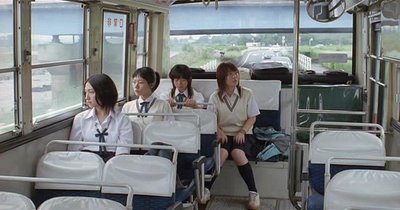
Besides, while the musical aspect is an important element of the film, its the story that matters most, and it is one that just about anyone can relate to. As I indicated before, the story is a very simple but truthful one. After a falling out between the band members that left them short two people, Kei, Nozomi and Kyoko have to find a new singer if they're going to perform at the festival. They get what they're looking for in Son (Doo-na Bae, from the wonderful Take Care of My Cat and the insane Sympathy for Mr. Vengeance); a Korean exchange student who they recruit almost entirely through coincidence. With their lineup complete, the girls practice themselves to exhaustion preparing for their performance, and spend the rest of their time just being together and strengthening the bonds of friendship between them.
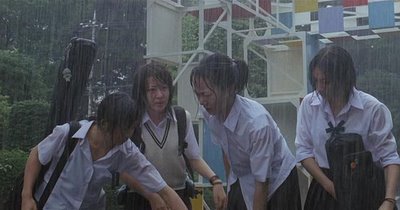
Aside from a handful of light subplots, that's really pretty much all there is to the film. But that's plenty, if you ask me. The story is real and honest, and stays focused on what's really important; the girls, their relationship with one another, the value of putting everything they have into achieving their shared goal, and the significance behind how they choose to spend their youth.
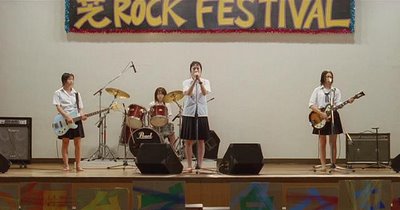
Linda Linda Linda is a great film that I can recommend to anyone at all without reservation. People who love Japanese music and love to study the significant bands of the past as much as the ones of the present should consider this one essential, but even people who don't recognize any of the names or songs thrown about in the film should find it easy to love nonetheless.
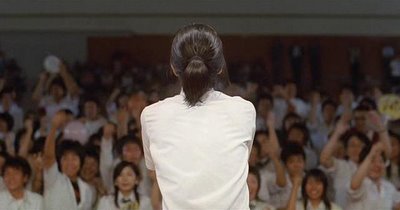
Score: 8/10 (Don't Miss It)

0 Comments:
Post a Comment
<< Home